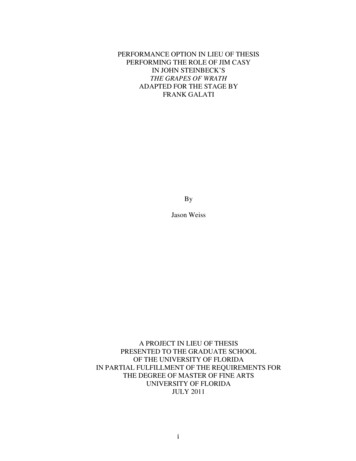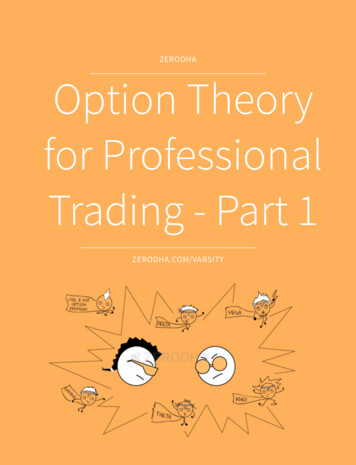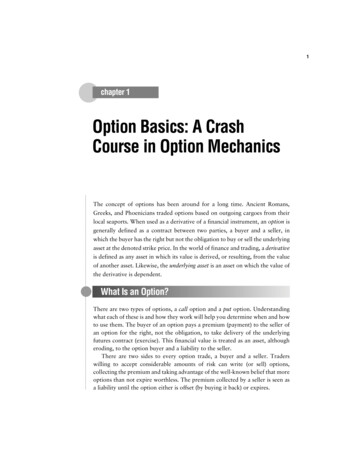
Transcription
PERFORMANCE OPTION IN LIEU OF THESISPERFORMING THE ROLE OF JIM CASYIN JOHN STEINBECK’STHE GRAPES OF WRATHADAPTED FOR THE STAGE BYFRANK GALATIByJason WeissA PROJECT IN LIEU OF THESISPRESENTED TO THE GRADUATE SCHOOLOF THE UNIVERSITY OF FLORIDAIN PARTIAL FULFILLMENT OF THE REQUIREMENTS FORTHE DEGREE OF MASTER OF FINE ARTSUNIVERSITY OF FLORIDAJULY 2011i
TABLE OF CONTENTSPAGEABSTRACT iiiINTRODUCTION .1RESEARCH .5I.TOM JOAD VERSES JIM CASY .5II.JIM CASY ON PAPER .8III.EXPLORING THE PLAY .11REHEARSAL PROCESS .13I.DIALECT WORK 13II.PHYSICALITY 17III.SOUL 23SELF EVALUATION: PERFORMANCE AND PROCESS .28I.TECH WEEK AND OPENING NIGHT .28II.LESSONS FROM THE RUN .37III.EVALUATION OF MY PROCESS .40CONCLUSION .42BIBLIOGRAPHY .44APPENDICES .45A. PRODUCTION PROGRAM 45B. PRODUCTION REVIEW 58C. PRODUCTION PHOTOGRAPHS .60D. BIOGRAPHICAL SKETCH .62ii
Abstract of Performance Option in Lieu of ThesisPresented to the College of Fine Arts of the University of Floridain Partial Fulfillment of the Requirements for theDegree of Master of Fine ArtsPERFORMING THE ROLE OF JIM CASYIN JOHN STEINBECK’STHE GRAPES OF WRATHADAPTED FOR THE STAGE BYFRANK GALATIByJason WeissJuly 2011Chair: Tim AltmeyerMajor: TheatreThis paper details the creative and technical processes implemented in developing therole of Jim Casy in John Steinbeck’s The Grapes of Wrath adapted by Frank Galati. Theperformance took place in the Constans Theatre in the Nadine McGuire Theatre andDance Pavilion at the University of Florida from January 28 – February 6, 2011. Thepaper has three sections that are devoted to detailing the development of the role of JimCasy which are: initial research, the rehearsal process and a self-evaluation of myperformance and acting process. This paper details the amalgamation of internal andexternal acting approaches used in creating an honest and interesting portrayal of JimCasy.iii
INTRODUCTIONJohn Steinbeck’s The Grapes of Wrath is a milestone of American literature. Itillustrates the conflict between the powerful and the powerless, highlighting one man’svehement reaction to injustice (Tom Joad), another man’s quest for peace and equality(Jim Casy), and a woman’s steadfast strength (Ma Joad). The novel captures the despairof the Great Depression and examines the very nature of equality and justice in America.Although it follows the journey of the Joads, an Oklahoma family who have been drivenoff their homestead and forced to travel west to the promised land of California, the noveltells the story of thousands of men and women whose plights would transform the nation.Out of the family’s many trials and tribulations against the hard realities of a countrydivided into those who have and those who do not evolves a drama that is intenselyhuman, yet majestic in scale and moral vision; elemental, yet plain spoken; tragic, butultimately stirring in its human dignity.My own personal journey to John Steinbeck’s The Grapes of Wrath, adapted forthe stage by Frank Galati, was filled with almost as many twists and turns as the Joads’trek to California. It began fifteen years ago in the summer of 1996. I was interning atFlat Rock Playhouse in Flat Rock, North Carolina, and was 3 months away from enteringmy senior year at the University of Miami, where it had been announced that The Grapesof Wrath would be the first show of the season. At this time, I was considered the topactor in the program and the ubiquitous choice to play the central role of Tom Joad. The2
director of the show, Bruce Lecure, was not only my advisor, but I was also his teachingassistant and, in many ways, his friend. In other words, the role was mine.At the time, I was 21 years of age, abound with confidence, and believed that Iwas a year away from taking Hollywood by storm. Since I had so many factors on myside, I didn’t think I had to do too much to prepare for the audition. I did not bother toread the novel, nor did I do any research about the era. My preparation consisted solely ofwatching the 1940 film version starring Henry Fonda (or at least the first and last twentyminutes of it). When I arrived back in Miami in late August of 1996, I went to theaudition with the confidence of Achilles at the gates of Troy. At the callbacks, I ignoredall of the training I had received, and conducted myself like a young man with a silverplatter in front of him. As a result, I ended up doing a poor imitation of Henry Fonda.There was no hunger, desire or baring of my soul to show the director that I was the manfor the job. At the end of the day, I got the impression that something had gone terriblywrong.The following morning, I pushed my way through the crowd at the callboard tocheck the cast list, and was shocked that I didn’t see my name next to “Tom Joad.” Thename on the sheet was foreign to me; a graduate student from the English department.When my initial shock subsided, I scanned down the sheet to find my name, only todiscover that I was to play “First Narrator” and “Man with Guitar.” I stood there for amoment with my mind racing and then retired to my apartment where I contemplatedwhether or not I should accept the roles. I felt as if I had been slapped in the face, and thatslap stung all the more because the assailant was my mentor. I spoke to Bruce in thecoming days to ask him why he had not cast me as Tom Joad. After all, I deserved the3
role, and everyone knew it. Why would he cast a graduate student in the Englishdepartment who had never been in one of our plays before? His reply was very simpleand without cushion. He told me that he gave me every chance to earn the role, but that inread after read, I did nothing to show him that I deserved it. I didn’t show him anypassion, spirit, danger or desire. I had relied on my relationship with him to get the role,rather than showing him via preparation and hard work that I was best suited for it.My young and arrogant ears were not ready to hear such unfiltered truth, and ittook me some time to understand that Bruce Lecure had taught me the most valuablelesson I would learn at school. His words ring in my ears to this day and, because of that,I never take any opportunity for granted. Not getting cast as Tom Joad became the firstdefining moment of my young career. I vowed to myself that I would one day play therole, and I would play it to the best of my ability.Many years have passed since my senior year at the University of Miami. In thattime, I earned my way into 3 acting unions, performed professionally in dozens of NewYork theatres as well as regional theatres and Shakespeare festivals. I appeared in severalfilm and television projects, including a 3-year stint on a major ABC daytime drama. Ishot or provided voice-overs for a dozen national and regional commercials, and Idirected for the stage and the camera. I am currently pursuing a Master of Fine Artsdegree in Acting at the University of Florida. I’ve accomplished many of my goals overthe years, and I can look at my career and consider it a success. However, one of mygoals has always eluded me. Throughout all my time in New York City and Los Angeles,I never got the opportunity to audition for The Grapes of Wrath, and therefore fulfill myvow to play Tom Joad. I began to think it would never come to fruition, and that I would4
have to move on with my life and my career—until the opportunity finally presenteditself to me.In the fall of 2009, the first semester of my 2nd year at the University of Florida,my class was charged by the Season Planning Committee of the School of Theatre andDance to suggest plays that offered us potential thesis roles, performance projects that arethe culminating event of the three year actor training program. I saw in this anopportunity I could not ignore. Due to the current state of our economy, The Grapes ofWrath was perhaps the most relevant it had been in years, and I was finally at anappropriate age to play the seminal character of American literature at the center of thisstory. I proposed the play to the committee and wrote a thorough argument for it. To mygreat satisfaction, The Grapes of Wrath was ultimately chosen for the 2010-2011 season.After years of waiting, wondering and hoping, my ambition to play Tom Joad couldfinally be realized, and this time I was ready to earn it.RESEARCHI.TOM JOAD VERSES JIM CASYWhen I had my first meeting with Dr. Charlie Mitchell, the director of TheGrapes of Wrath, he asked me whom I wanted to play as my thesis role: Tom Joad or JimCasy? The question surprised me. Fifteen years of longing had made me intent on playingonly the former. I told him that I hadn’t even considered playing Jim Casy. He told me totake the summer to think it over because he was of the opinion that Casy was the soul ofthe play and that, while he was certain I would make a fine Tom Joad, he believed that5
Casy would be the role into which I could really sink my teeth. Doubtful, I reluctantlyagreed to take the summer to think about it. However, it would not be like the summer of1996 when I prepared by watching part of a film and nothing more. This time, I would domy due diligence and leave nothing to chance.I looked deep into the character of Tom Joad to find his center. I pictured myselfas Tom as I read, with all of his actions being performed and all of his lines being spokenby me. This wasn’t particularly difficult, seeing as I had been fixated on this character for15 years. As I read the novel, I paid close attention to all of the descriptions of Tom Joad,and made many margin notes with ideas for character work such as: He is not over 30 His eyes are very dark brown His hands are hard He is tallThe physical characteristics were very close to my own, making the role a good “fit”.Also, I found his outlook familiar as well. When he returns home from prison and Maasks him if prison life has made him angry, Tom replies, “I was for a little while. But Iain’y proud like some fellas. I let stuff run off’m me” (Steinbeck 76). His time in prisonhas given him a new perspective and he wants to make a new and honest life for himself.I can understand that point of view because it parallels my choice to leave New York andgo back to school. Like Tom, I had to leave my pride behind so that I would be able togrow and start a new life in school. Furthermore, I was also drawn to his transformationin the story. By the end of the novel, Tom’s outlook has changed drastically and he is6
more concerned for his fellow man than he is for himself. This is best expressed in hisfinal conversation with Ma:I’ll be all aroun’ in the dark. I’ll be ever’where – wherever you look.Wherever there’s a fight so hungry people can eat, I’ll be there. Whereverthere’s a cop beatin’ up a guy, I’ll be there. If Casy knowed, why, I’ll be inthe way guys yell when they’re mad an’ – I’ll be in the way kids laughwhen they’re hungry an’ they know supper’s ready. An’ when our folkseat the stuff they raise an’ live in the houses they build – why, I’ll be there.See? God, I’m talking like Casy (Steinbeck 419).This presented a rich and interesting character arc for the role. When I was through withthe novel, I knew that I could play Tom Joad and was convinced that I could play himquite well. However, I told Dr. Mitchell that I would consider both characters, so I pickedup the book again and started from the beginning, this time focusing on Jim Casy, theman whom Tom, by his own admission, comes to emulate.Admittedly, this was a much more difficult task. I had already done thegroundwork for Tom and was convinced I wanted to play him. It was not easy to get thevoice of Tom Joad out of my head. Despite the difficulty, I forged ahead, pencil in hand,on my path to “discovering” Jim Casy. Again, I marked all descriptive passages and tooknotes in the margins.As I read, a clear picture of Casy began to take shape in my head. I could see himand hear him in my mind’s eye. He was like a homeless drifter I might see on the streetsof Gainesville or a subway car in New York City:7
Lean and sinewy Grey haired and road worn Eyes that have seem many things they’d like to forget A man on the edgeThe character became clearer as I read, and I started to understand what Dr. Mitchellmeant when he said Casy is the “soul of the play.” He is a man who knows that he wantssomething else, but isn’t sure of what it is. He knows there has to be something better, butdoesn’t know where to find it. He is a simple man full of complexity, and although he iswandering, he certainly is not lost. Casy intrigued me because I could see so much ofmyself in him. He carries around the pain of his past, but does not pin it to his sleeve forall to see. Like other characters in The Grapes of Wrath, Jim Casy is highly symbolic andrepresents a specific point of view that was held by a certain segment of the migrantpopulation of the Great Depression; one that believes that, at its core, humanity is divineand has the ability to save itself. This was a point of view with which I connected. Thesewould be the qualities that eventually drew me even more strongly to Casy than to TomJoad.II.JIM CASY ON PAPEROnce I embraced the idea of playing the role, I soon realized how loaded JimCasy is as a dramatic figure. He is a former preacher and long-time friend of the Joads.He is a latter-day Christ figure who longs to bring religious stability to the migrantfamilies heading west. Steinbeck goes so far as to give Jim Casy the exact initials as thebiblical Savior (J.C.), yet Casy’s relation to Christ goes beyond the superficial, and plays8
out in their similar plans of action. Much like Christ, Casy is a radical, challengingauthority and risking persecution as a union instigator, and like Christ, becomes a martyrfor his beliefs. Also, like Christ, he retreated into the forest in order to soul-search and todiscover the answers to difficult questions. He actually compares himself to Christ andhis actions while saying grace at the Joads’ breakfast table, “.I been in the hills, thinkin’,almost you might say like Jesus went into the wilderness to think His way out of a messof troubles I got tired like Him.I got mixed up like Him” (Steinbeck 81). I realized thatCasy offered me a rich, almost mythic character and back-story that could be a rewardingexploration for me as an actor.Furthermore, I discovered that, although his participation in the narrative wanesas they approach California, the first half of the novel rests heavily on Casy as a spiritualguide for the Joads. Even though he has given up his belief in the traditional idea of God,in the eyes of the Joads, Casy is still “The Preacher.” But he is a disillusioned man ofGod, in part because of his tendency to sleep with women to whom he preaches: “Thenyou know what I’d do? I take one of the girls out in the grass an’ I’d lay with her. I doneit ev’ry time” (Steinbeck 22). This flaw makes Casy human, and I found him to be easilyrelatable as a man confused about himself, searching for a greater purpose.I was also intrigued by the early exchanges between Tom and Casy. Casy says,“‘What’s gnawin’ you? is it the screwin’?’ An’ I says, ‘No, it’s the sin.’ An’ I says, ‘Whyis it that when a fella ought to be just about mule-ass proof against sin, an’ all full up ofJesus, why is it that’s the time a fella gets fingerin’ his pants buttons?’ I says, ‘Maybe itain’t a sin. Maybe it’s just the way folks is’.” Casy continues, explaining his newphilosophy, “I don’t know nobody named Jesus. I know a bunch of stories, but I only9
love people.” He says, “I figgered about the Holy Sperit and the Jesus road. I figgered,Why do we got to hang it on God or Jesus? Maybe, I figgered, maybe it's all men an' allwomen we love; maybe that's the Holy Sperit - the human sperit - the whole shebang.Maybe all men got one big soul ever'body's a part of. Now I sat there thinkin' it, an' all ofa sudden--I knew it. I knew it so deep down that it was true, and I still know it”(Steinbeck 24). I was attracted to Casy’s blunt honesty.After Casy dies, Tom, like one of Casy’s disciples, talks of the preacher, recallingthat, “One time he went out in the wilderness to find his own soul, an’ foun’ he didn’have no soul that was his’n. Says he foun’ he jus’ got a little piece of a great soul Iknow now a fella ain’t no good alone” (Steinbeck 403). This “great soul” becomes one ofthe main themes in the novel, the seeds of which are planted by Casy. If Casy’s speechplanted the seeds, his actions, and ultimately his death, are what germinate them. This canbe seen when Ma replies to Tom’s statement and comes to acknowledge thisinterconnectedness: “not even so self-contained as a single family but all the destitute as asingle soul” (Steinbeck 404). And it is perhaps no more stunningly expressed than in thenovel’s climactic moment when Tom Joad’s sister, Rose of Sharon, allows a starvingstranger to drink milk from her breast. Steinbeck’s writing had made Dr. Mitchell’s casefor him, and the director was quite pleased to hear that I was excited to play the Christfigure Casy in The Grapes of Wrath. Interestingly, the investigation that followed Dr.Mitchell’s challenge that I consider the role of Casy over Tom prompted some valuableself-discovery. In the process, I realized that I was no longer interested in playing aleading role solely because it is the lead. Instead, I’d rather play a character that has acompelling arc, and whose journey has many obstacles in its way. I enjoy playing quirky10
character types, violent and dangerous characters, anti-heroes and other non-leading mantypes. I find these characters to be fulfilling, enlightening, and fun. This is perhaps thereason why I have still not played the role of Tom Joad; he may not be the “best fit” formy tastes and talents. Regardless, I now had a decisive goal, albeit different from thegoal I had imagined for 15 years, and could commence with my character research anddevelopment of Jim Casy.III.EXPLORING THE PLAYBefore rehearsals began, I prepared by reading the play adaptation by FrankGalati. The first thing I noticed was the playwright’s description of Casy’s clothing in theappendix of the play: “Distressed summer linen two piece suit, textured vest, distressedcanvas shoes, black bowler hat, distressed formal shirt, rope belt, maroon kerchief”(Galati 112). This description gave me a sense of the life Casy had lived up until theopening moment of the play. Everything about his wardrobe indicates that he has a roughand worn appearance, suggesting that he has been on the road for quite some time, facinghardship; a man of the land who survives by his own perseverance and by the good willof people he encounters along the way. Therefore, I knew that clothing would be a veryimportant issue for me as an actor, so I emailed the costume designer, Rebecca JoyWallace, to ask if I could have some input into my wardrobe. I believe that, as an actor, Ishould play a part in designing my wardrobe because, at the end of the day, it’s mycharacter. I think it is preposterous for an actor to spend months researching anddeveloping a character only to be given a costume that may or may not be what that actorhad been imagining. I told her that “finding” Casy would be a process for me, and that I11
would like the chance to develop his wardrobe in rehearsals. When she replied in thepositive, I was relieved. The two of us met and she showed me her initial renderings ofCasy’s costume. It consisted of a large preacher’s hat, a blue shirt, and an old worn suit.I was immediately drawn to the suit, though skeptical about the preacher’s hat.Throughout the play, Casy states that he’s not a preacher on 4 separate occasions. Thisbeing the case, I did not think that he would wear an article of clothing that would giveanyone the impression that he is still a preacher. However, I put my doubts momentarilyaside: after all, I had also been skeptical about playing Casy at one time. We happilyagreed to let the costume evolve over the course of rehearsal. This accommodation byMs. Wallace was indicative of how collaborative the entire process would be.As I read the play, I was reminded that, as a former preacher, Casy used to bequite a talker: “I did enough talkin’ when I was a preacher to last me the rest of my life”(Galati 41). He was a man who “showed people the way” and who set them on “the rightpath.” I had to ask myself what that meant. When crowds of people hang on one’s everyword, what does that do to a man? How does it affect his confidence and cadence and hiswillingness to be the man he strives to be? These questions would ultimately be exploredin detail during the rehearsal process. I did not want to make any firm choices prior. Onething was certain, though: Casy was a talker, a talker who spoke with passion and verve.Through his many long, eloquent speeches, the text made it clear that, even though hewas no longer a preacher, he certainly held on to his oratory skills. They define him, andas an actor playing Casy, it was my job to keep that in mind as I worked to render afaithful portrayal.12
REHEARSAL PROCESSI.DIALECT WORKOn Saturday, November 6th, 2010, the rehearsal process began with a reading ofthe script out loud by the full cast. The director chose to have us actors on our feet andmove around rather than sit at a table. The idea behind this was to allow us to find thecharacters in both our mouths and bodies. Up until this point, I had not made any firmchoices for Casy; however, before I knew it, a strong choice emerged on its own. By thetime I was through the first page of dialog, I found myself almost instinctively speakingwith a Southern drawl; a Georgia dialect to be exact. This was not planned at all, but as Iread further, and the scenes rolled on, the dialect slowed my speech pattern, and gave myvoice a gravelly depth and a certain gravitas that truly served Casy. I found that itseparated him vocally from the others in the play, namely the Joads, underlining his roleas “outsider”; and the Joads’ acceptance of an outsider like Casy into their close-knitfamily would only add to his mystique. I decided to explore this instinctual choice forthe remainder of the read, and found it nothing but useful. By the end of that firstrehearsal, I was certain that I was going in the right direction. The problem was thatnowhere in the script does it indicate that Casy is from Georgia. This was a majorconcern for me because I don’t believe that an actor should simply adopt a dialect for thepurposes of making his character more “interesting.” I spoke to the director after the read,and we agreed that the dialect was interesting, but that we had to find a way to justify it.The justification came rather quickly when we both recognized that Steinbeck neverreveals Casy’s home in the novel. This gave us the freedom to make creative choices13
regarding Casy’s past that still honored the logic of the story and the intent of the writer.My invention of Casy’s Georgia upbringing seemed capable of doing both.I spent the next week of rehearsals continuing my exploration of this dialect andfound that it not only aided in establishing a speech pattern, but that it affected mymovement and internal rhythms as well. The starting point for any dialect is to isolate thesounds that are specific to that dialect. For a Georgia accent, I started with its distinctive“R” sound. There are a lot of variations on what is commonly called a “Southern accent.”One variation typically doesn't have an “R” sound after vowels, like one often used in theplays of Tennessee Williams or found in Gone with the Wind. For this dialect, unless it iswritten before a vowel, the “R” is silent. For example, in the phrase, “A green bird isbrighter,” one striving to achieve the dialect would pronounce the “R” sounds in thewords “green” and “brighter,” but not in the word “bird” or the second syllable of theword “brighter”. Phonetically, the phrase would sound out as: A green bahd is brightah.This altered sound is what Arthur Lessac, voice and speech theorist, would call #3 vowelstructure, “A round lip opening [with] optimal space between the teeth, completecheek-muscle-yawn extension, and a lip opening just large enough to permit easy passageof the vertically positioned thumb” (Lessac 165). By allowing the aperture of the lips tobe relaxed and rounded, rather than tight and pulled back, I was able to achieve the soundI wanted on a regular basis without causing any vocal discomfort or strain, creating anauthentic dialect for the former Georgia preacher whom I was portraying.With this adjustment as a base, it became quite easy to find the rest of the voweland consonant substitutions that the dialect requires. The “oi” sound as in “joyful,” whichis known as #3y in the Lessac system, opens up and becomes more rounded and14
abbreviated. If done correctly, it will sound more like the #3 vowel sound, as in the word“law.” The long “I” sound in words such as “sign,” and “dry,” noted as #6y in the Lessacsystem, becomes a #6, like the vowel sound in “ask,” with “the tongue tip pressed gentlyagainst the lower teeth as the tongue widens a bit and the lips widen just enough toaccommodate the widened tongue while maintaining a relaxed forward facial posture”(Lessac 166). Also, the “ng” sound in words like “waiting” becomes “n”, sounding morelike “waitin.” However, to do the dialect properly, the “t” before the second syllable mustbe modulated as well, by swallowing the “t” sound and putting it in the back of the throatwith a slight guttural burst.I am lucky to have a very good ear for dialects, and can pick them up quite easily.However, the vowel and consonant changes are not enough to produce an authenticdialect. I also had to find the speech pattern and cadence of the regionalism. My ownspeech pattern is very different from the Georgia dialect. Growing up in and around NewYork City, I tend to speak quickly and relatively loudly. Neither qualities serve theSouthern dialect, so I had to find a way to slow my natural rhythms down and discovermore variety in volume and pace. In order to do this, I listened to as many authenticsources as possible. I was able to search for and listen to native speakers from specificregions of Georgia at YouTube.com, accent.gmu.edu, and myaccent.info. By listening torecordings of these people, I could more fully understand and emulate the nuanced pitchchanges and stress patterns of their colloquial speech.In order to further define and particularize Casy’s speech pattern, I also listened toSouthern preachers. My neighbor is a member of Westside Baptist Church in Gainesville,FL. She was kind enough to take me to Sunday services with her. While I was there, I15
heard Pastors Phil Young and Gary Crawford speak. While neither of them is fromGeorgia, both possessed a Southern “musicality” in their manner of speaking. I listenedto the way they shaped their words and sentences, both during the service and afterwardsas they were talking individually to parishioners, and I noticed a “certainty” in theirdelivery. I noted that their pitch, tone and volume changed often as they stressedparticular points. While many orators use these shifts to get their points across, thesegentlemen had an inviting, soothing tone; they did not lecture the crowd, but spoke tothem in such an eloquent way that I was subdued as if by a lullaby. I discovered thatlanguage is important for these men—what they say and how they say it—because it iswhat they use to spread the word of God, and each word must be cherished and given theopportunity to ring out like the bells of Saint Sebastian. In watching these men at work, Icame to realize that there are no inconsequential words to a Southern preacher.When I infused my portrayal of Casy with what I observed at the church that day,I came away with a more complete idea of who this man is. Casy understands the valueof language. He is not seeking adulation, nor is he seeking fame and fortune. He is a manon a spiritual path of discovery who is more interested in the safety of his fellow manthan for himself. His tools for that end are his words because, in many ways, words areall he has. He is in a unique position to understand the power of those words, as he hasabused them in the past to seduce young women. However, he has learned from themistakes of his youth and now brandishes his words with care. He knows that whether helikes it or not, people are going to listen to what he has to say due to the fact that he wasonce a preacher. This is a hard responsibility. This realization cemented in me the notion16
that Casy spoke slowly and with great intent; Casy is not a man of few words, but he is aman who carefully chooses when to speak.II.PHYSICALITYAs I explored in rehearsal how he might speak, I also began to discover howCasy might move as well. The speech patterns of rural Georgia have a slower rhythmthan my own speech, and I found that when I employed them in the rehearsal room, theyalso slowed my movements. The slower rhythms gave Casy a pensive quality that did notallow for sharp and sudden movement. My interpretation of Casy was a contemplativeman who would not act without thinking.Also, it was important for my physical character work to acknowledge that Casyis much older than me. Tom is described as “not being over thirty” (Steinbeck 6), whichimplies that he is in his late twenties. In their first meeting, Casy says to Tom, “Youwouldn’t remember me, I guess. Baptized you in the irrigation ditch” (Galati 10). If hebaptized Tom when he was a young child, then Casy m
John Steinbeck’s The Grapes of Wrath is a milestone of American literature. It illustrates the conflict between the powerful and the powerless, highlighting one man’s vehement reaction to injustice (Tom Joad), another man’s quest for peace and equality (Jim Casy), and a woman’s ste










